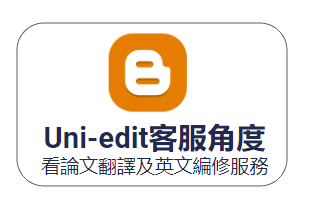難度:初階
Uni-edit的客戶許多是漢語和日語背景,有時候會把「一方」或「一方面」逕翻成on the other hand和besides,不過在英語,這些字的意思其實相當不同。
On the other hand
On the other hand是用來表示對立的因素,或支持對立意見的因素,代表作者正再三斟酌,或打算做決定,則On one hand…On the other hand…(一方面……另一方面……)為慣用且固有的句型。
正確:Some researchers have suggested metallic carbon nanotubes as a potential material for the construction electrical circuits like those in computer chips. Metallic carbon nanotubes possess high thermal stability, thermal conductivity, and current carry capacity. On the other hand, their fabrication is a challenging and time-consuming process, and there is no suitable mass production method at present.
(中譯:若干研究人員指出,金屬奈米碳管是用在電腦晶片等構造電路的可能材質。金屬奈米碳管具備高度熱安定性、熱傳導性,和載流能力;另一方面,加工是棘手且耗時的過程,現階段尚無合適的量產方式)
Besides
Besides為引進其他概念或說明,代表作者已做出決定;besides引進的理由為既定最佳決策提供更多的證據。
正確:Based on this evidence, we did not employ metallic carbon nanotubes to construct our chips. Besides, the speed of existing technology is suitable for our purposes.
(中譯:依據證實,故我們未採用金屬奈米碳管作為晶片構造,況且,現有技術的速度已適合我們的目的)
因為besides提出的是發現結果的事後補充,讀者可能覺得毋需理會甚至偏頗。事實上考量添加多餘的理由會稀釋原先論點,講究的學術作者很少用besides。
改用moreover或in addition是不涉及說理的講究替代方案;適用於更多支持主要論點或立論的事實。
正確:Based on this evidence, we did not employ metallic carbon nanotubes to construct our chips. Moreover, the speed of existing technology is suitable for our purposes.
(依據證實,故我們未採用金屬奈米碳管作為晶片構造,而且,現有技術的速度也適合我們的目的)
Download Tip Here:  “On the other hand” vs. “Besides”
“On the other hand” vs. “Besides”
Uni-edit English Writing Tip 010: "On the other hand" vs. "Besides"
Difficulty: Easy
Many Uni-edit customers are from Chinese & Japanese language backgrounds. Our customers sometimes translate the characters “一方” or “一方面” into English as “on the other hand” and “besides” synonymously. However, these words have quite different meanings in English.
On the other hand
“On the other hand” is used to present factors that are opposed, or that support opposing opinions. It suggests the author is deliberating, or in the process of making a decision. "On one hand ... On the other hand..." is a commonly used and natural structure.
Correct: Some researchers have suggested metallic carbon nanotubes as a potential material for the construction electrical circuits like those in computer chips. Metallic carbon nanotubes possess high thermal stability, thermal conductivity, and current carrying capacity. On the other hand, their fabrication is a challenging and time-consuming process, and there is no suitable mass production method at present.
Besides
“Besides” is used to introduce an additional idea or explanation. It suggests the author has already made his decision; reasons with “besides” are just more evidence for a decision that is already known to be optimal.
Correct: Based on this evidence, we did not employ metallic carbon nanotubes to construct our chips. Besides, the speed of existing technology is suitable for our purposes.
Because “besides” gives an after-the-fact reason for a finding, it can sound dismissive or even prejudiced. In fact, careful academic writers rarely use “besides”, because inserting extra, unnecessary reasons dilutes the original argument.
Saying “moreover” or “in addition” is a sensible alternative that does not imply rationalizing. That implies the additional fact supports the main argument or line of reasoning.
Correct: Based on this evidence, we did not employ metallic carbon nanotubes to construct our chips. Moreover, the speed of existing technology is suitable for our purposes.



